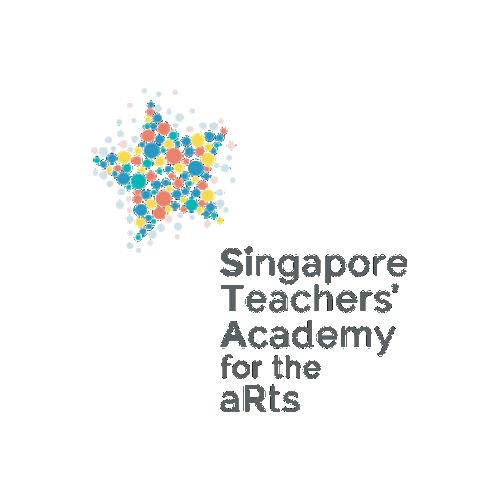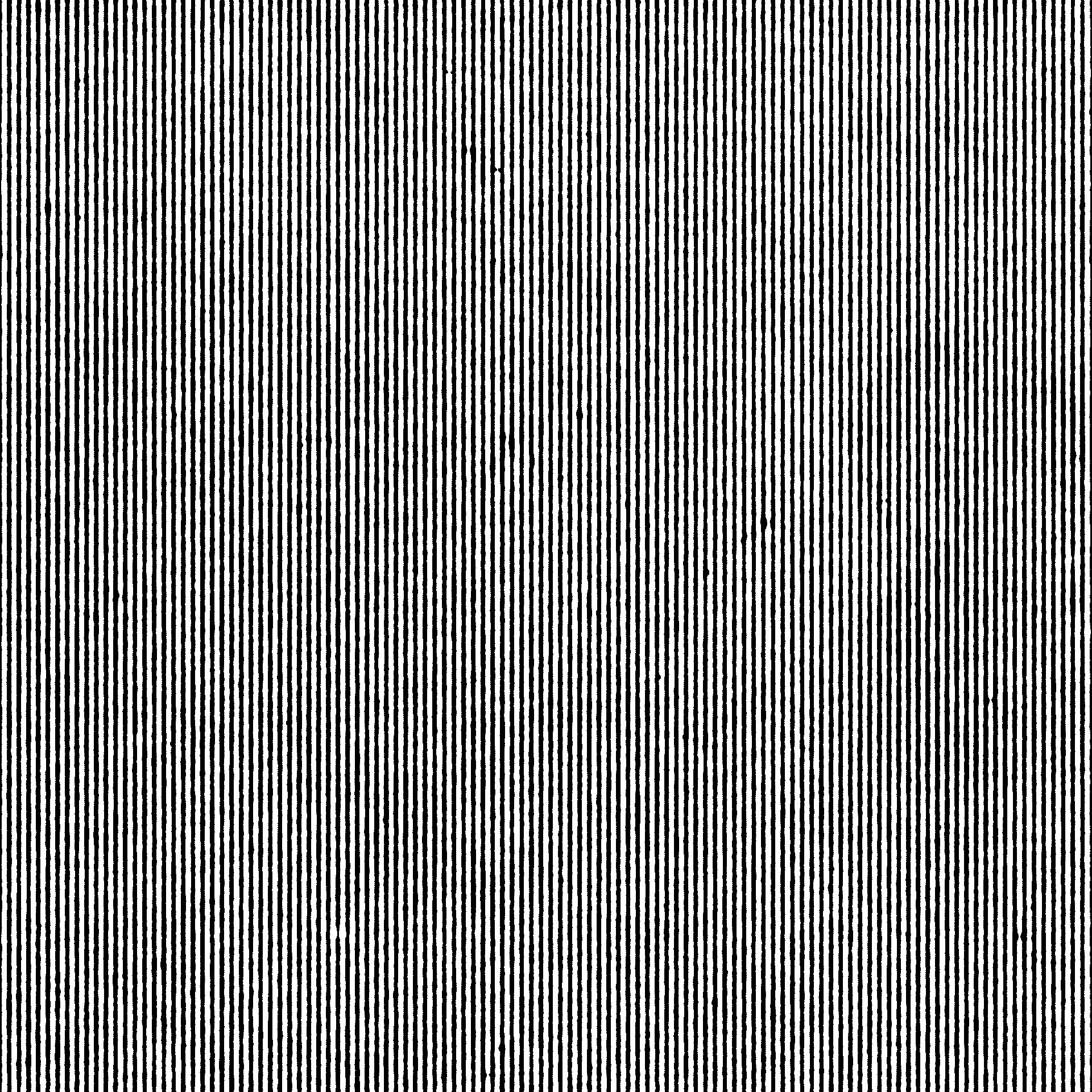

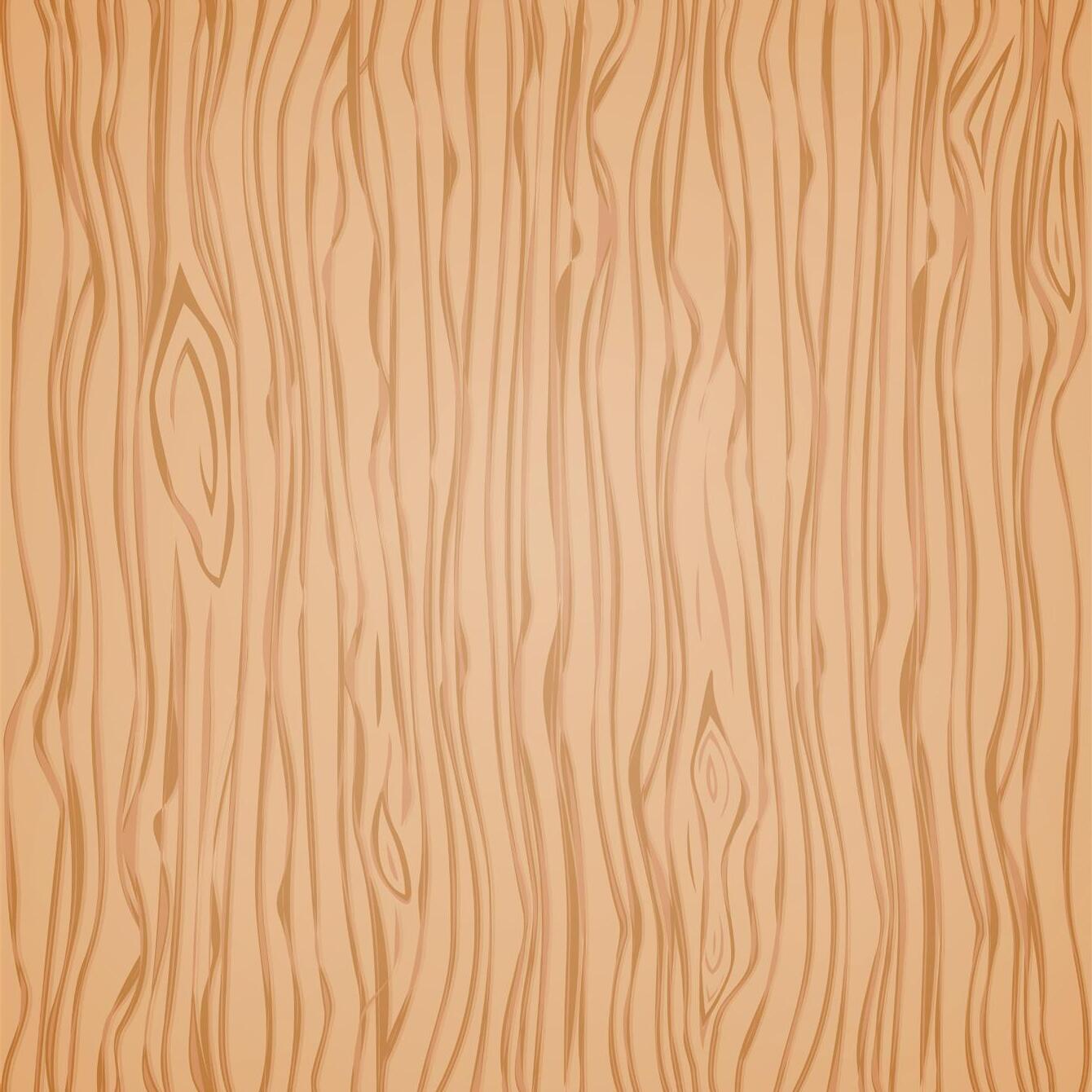


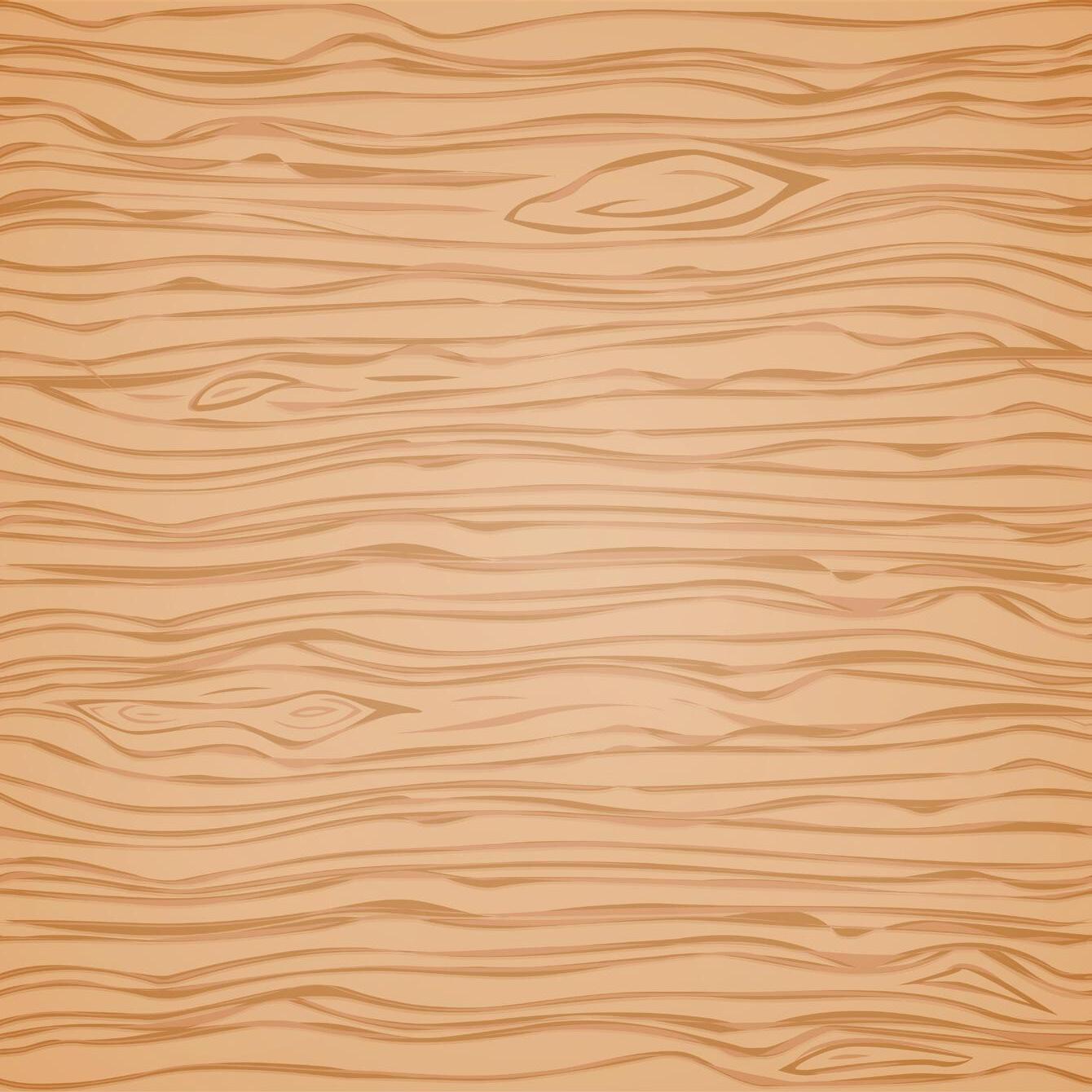












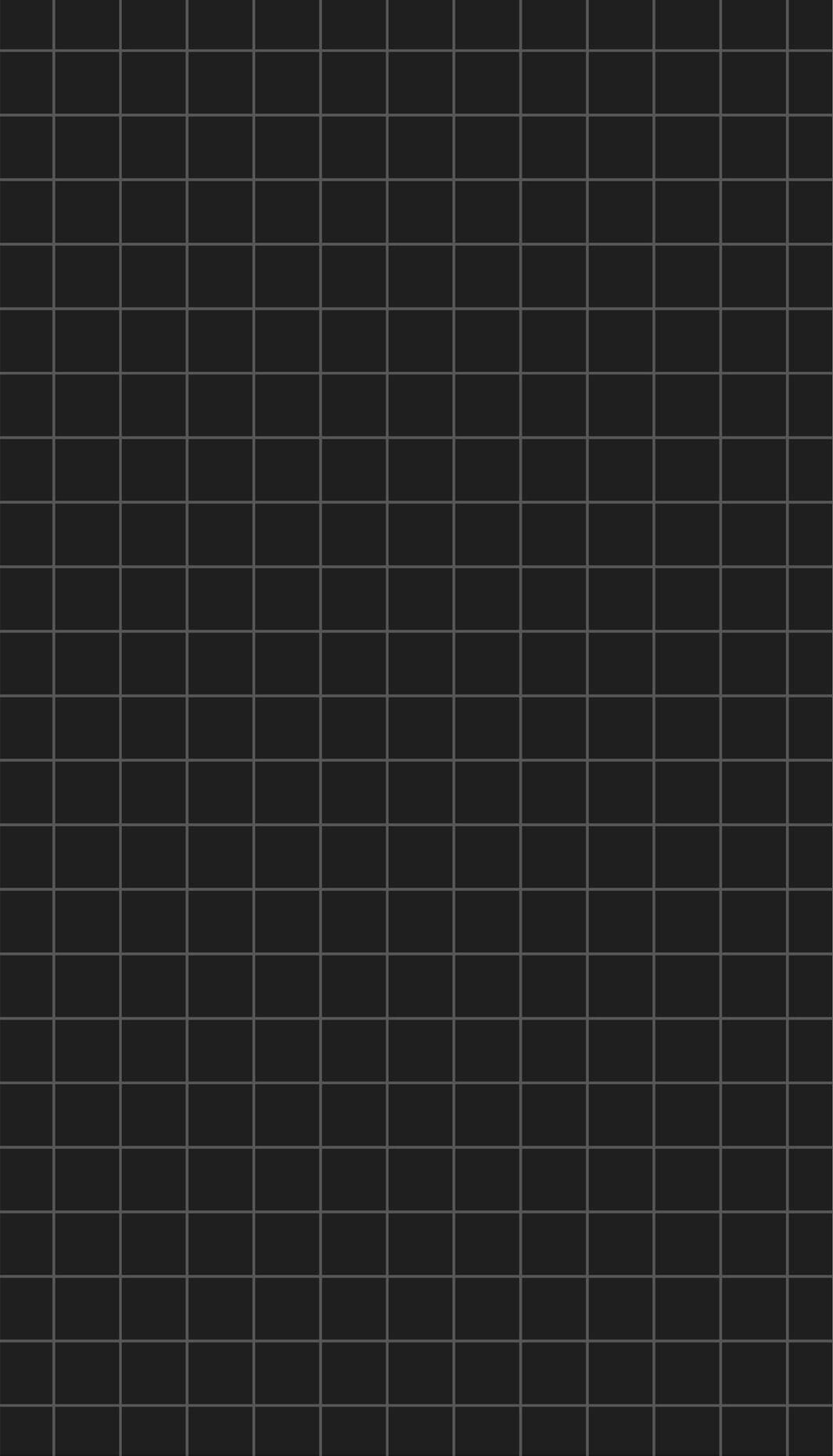


























Foreword
Which Art Teacher Are You?
Conversations about Artmaking: What, Why and How
•Keep Calm and Draw:
•Mindful Drawing Practices for Busy Art Teachers
•Keeping the Creativity Spark Alive:
•Primary Art Teacher Conversations
•Teacher-Artist Insights from Hairol
•Inspiring Words from Juditha
Inside the Art Teacher’s Sketchbook
•Sketching the Journey of Growth
•Drawing Without Fear
•The Artist-Teacher in the Classroom
What Struck You?
• Reflection on January STAR Post
• Reflection on Assessment Training Workshop
• Reflection on Visiting Art Exhibitions
Welcome to the Fraternity Takeaways from a Beginner Teacher
Our Team
As art teachers, we chose this path driven by our love for the subject and belief in sharing the transformative power of being involved in Art. Yet, as we juggle the demands of teaching and life, maintaining our own artistic practice, that very spark that drew us to teaching in the first place, can be challenging. How do we stay inspired and champion the value of our subject?
This edition of STAR Post explores these questions through the voices of fellow educators. a_edge 2024 participants Kirthi, Dominic, and Mary share candid reflections on balancing teaching with personal artistic pursuits, while Nicole from the National Institute of Education (NIE) offers practical ways to reconnect with our artistic selves through mindful drawing practices.
Our role as art educators is multifaceted – a strength to embrace. Hairol demonstrates this by “walking the talk”, where his artistic practice enriches his teaching. Juditha's experience with the Drawing Networked Learning Community shows how rediscovering our passion for artmaking can energise both the teaching and creative practice.
Through the sketchbook pages of Vernice, Jessica, and Wei Hou, we glimpse intimate creative journeys that bring fresh perspectives to their classrooms. In our “Which Art Teacher Are You?” section, whether you identify as an “Art Advocate”, “Creative Guide”, or “Connection Catalyst”, your unique approach enriches Singapore's art education landscape. This issue reminds us that keeping our artistic practice alive maintains the relevance that and makes our teaching meaningful. As beginning teacher Katie reflects, we grow alongside those we teach, finding new ways to stay inspired while inspiring others.
Let's continue nurturing both the teacher and artist within us, knowing that this combination uniquely equips us to inspire ourselves and the next generation of creative thinkers.
Ms Han Zi Rui Senior Assistant Director (Art) STAR
Discover the unique strengths you bring to the art classroom – whether you’re sparking curiosity with unconventional techniques, finding beauty in everyday life, or championing interdisciplinary collaboration.
You’re an
Art Advocate!
You’re a passionate champion of creativity – a voice that speaks up for the transformative power of the arts in every corner of life. Whether you're rallying for arts education, curating meaningful experiences, or sparking cultural conversations, you believe art isn’t a luxury – it’s a lifeline.
You see its potential to heal, disrupt,


You’re the calm in the creative storm – a steady hand and a wise heart who helps others find their way. As a mentor, facilitator, and gentle catalyst, you
You listen deeply, encourage bravely, and create safe, inspiring spaces where others feel seen and supported. Whether you're guiding someone through artistic doubt, helping them refine their vision, or simply reminding them of their worth, your presence sparks clarity and confidence.
You walk beside others on their creative path – not to lead them, but to help
You're a bold explorer on an endless creative quest. You thrive at the edge of the unknown, where ideas are raw, rules are optional, and magic happens.
Whether it's mixing unexpected materials, diving into unconventional
Fearless and curious, you turn every project into a journey, pushing past comfort zones to discover new artistic frontiers. While others stick to the
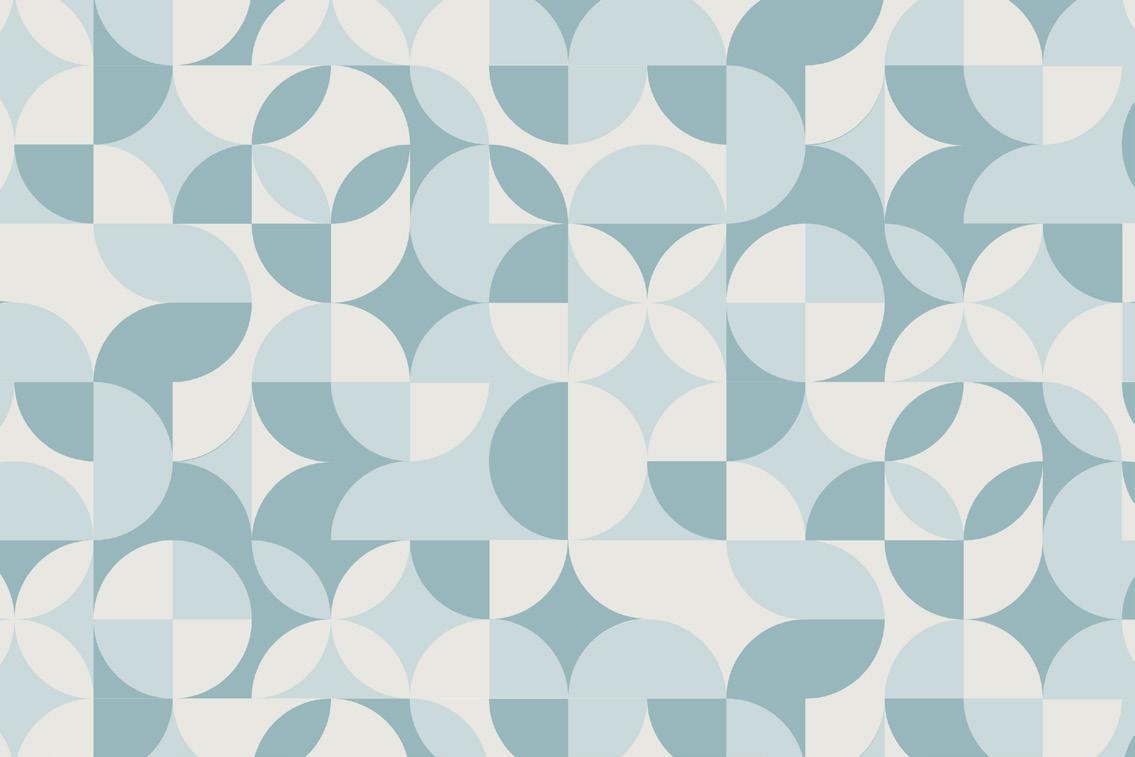
You move through the world with wide eyes and an open heart. To you, creativity begins with the glint of light on a puddle, the rhythm of footsteps, or a forgotten object whispering stories. You find awe in the ordinary and beauty in the in-between.
Curiosity is your compass, leading you to unexpected places and fresh perspectives. Whether you're wandering through nature, people-watching in a cafe, or flipping through old books, you're always on the hunt for that spark of wonder that others might miss. You remind us that magic is everywhere — if only we take the time to look.

You're a
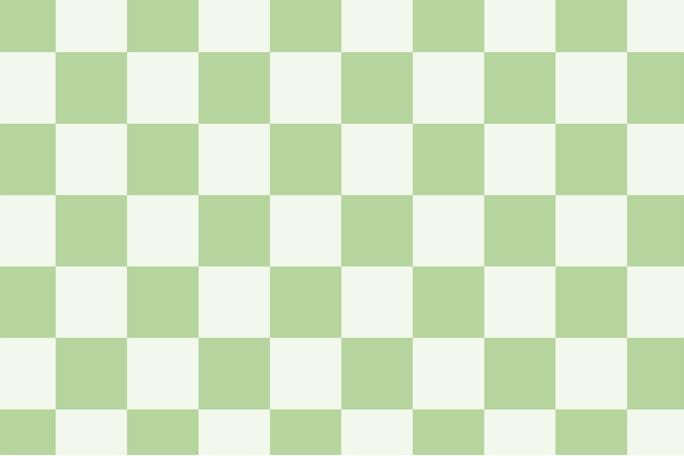
You're a creative shapeshifter, turning the simplest moments of play into gold. With a heart full of curiosity and a mind wired for exploration, you blend imagination, experimentation, and a dash of chaos to uncover surprising insights and artistic gems.
You believe that play isn't just for fun it's a serious tool for invention, and transformation. you're mixing media like potions, building worlds from scraps, or asking wild “what ifs”, your joy is contagious and your process, magical.
While others seek outcomes, you chase wonder – and in doing so, you turn play into pure creative alchemy.
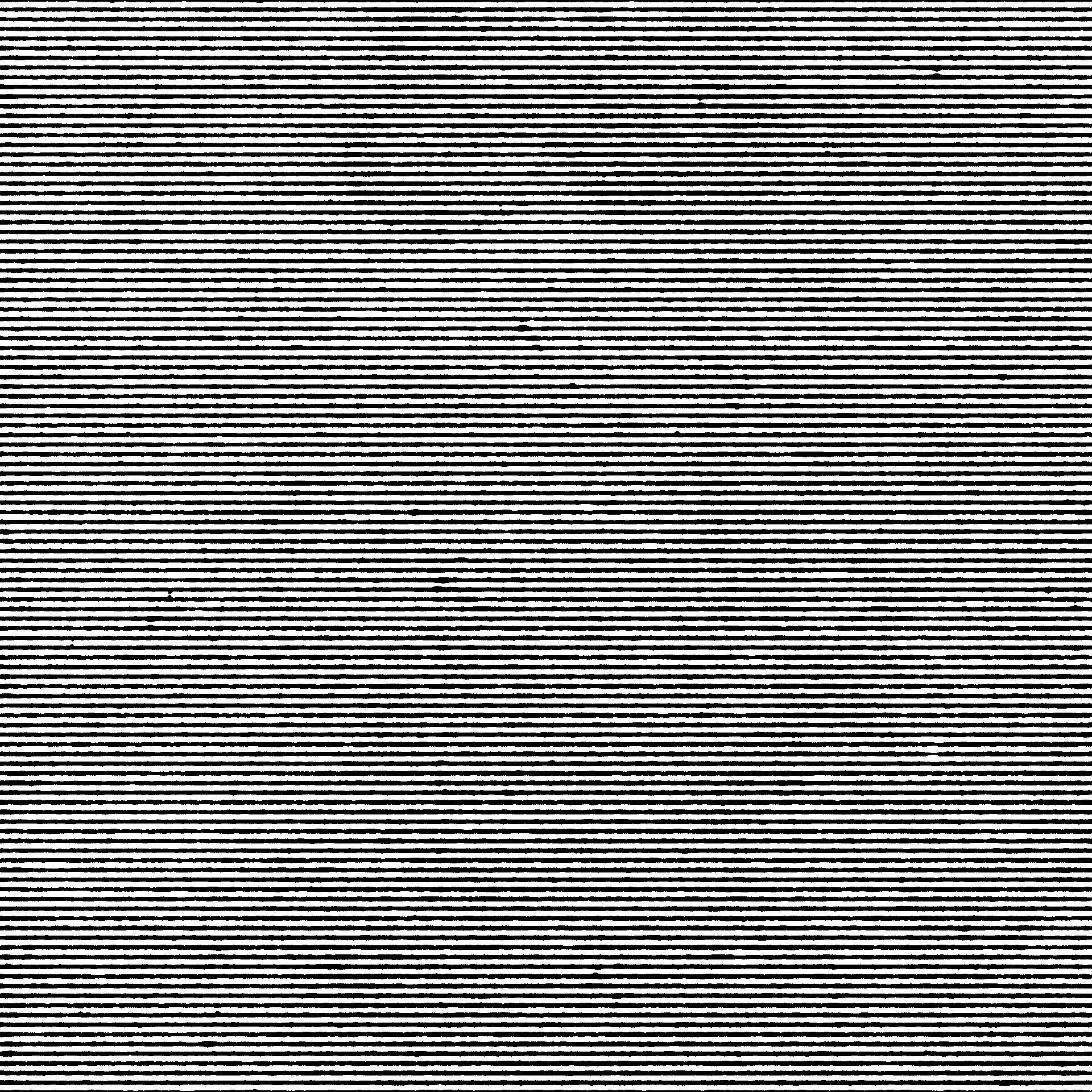


In the midst of another busy school day, drawing can provide a much-needed pause. Ms Nicole Choo Sze Mying from the National Institute of Education recommends trying these three mindful drawing exercises to reconnect body and mind.
Ms Nicola Choo Sze Mying Adjunct Faculty, Department of Visual and Performing Arts, National Institute of Education
In the busy, noisy, deadline-rushing, work-filled life that we call School, drawing offers a unique way to pause, breathe, and recalibrate body, mind, and some say, soul. Neuroscience research shows that drawing shifts brain activity from analytical to visual-spatial processing, much like the effects of meditation on the brain.
This shift occurs because drawing demands close observation and conscious attention. Whether it’s a one-hour sketch of the urban landscape, a 15-minute sketch of breakfast, a three-minute blind contour drawing or a one-minute breath drawing, our focus becomes attuned to what is in front of us in the present moment. Through this mindful way of drawing, we enter what psychologists call a “flow state” – a condition of complete immersion that quiets the mind’s constant chatter. Our hand and pencil begin to act as an extension of our breath, thoughts, and feelings.
This mindful approach to drawing is not about creating accurate and realistic drawings. It is about training perception and presence.

Here are some simple exercises you can try:
On blank paper, start at one side and draw a light upward line as you slowly inhale through your nose. Match the movement of your hand to the rhythm of your breath. As you exhale through your mouth, press down and draw a heavier downward line. Repeat this cycle for one minute. Closing your eyes helps reduce visual distractions and deepen the focus on breath and movement.
Select an object (like your hand). Trace your eyes along all the edges and visible lines. Without looking at your paper, focus on matching the movement of your hand and pencil with the movement of your eye. Keep your focus on the object, not the drawing. You can vary the time from one to 10 minutes and even try an entire scene in front of you.

Close your eyes and turn your attention inward. Imagine your entire body as a river, and picture yourself standing in the middle of it. What does this river look like? Is it moving fast or flowing slowly in waves, spirals, or circles? What is its rhythm: choppy, pulsing, or gentle? Is the rhythm consistent, or more intense in certain areas? What colours come to mind?
For art educators, this mindful practice holds power, as it nurtures both personal wellbeing and professional insight. Personally, it offers a way to reconnect with the joy of process, especially when the demands of teaching leave little time for our own creative practices. Professionally, drawing with mindfulness sharpens our ability to notice, be present with students, and model what it means to engage with learning itself. It reminds us that artmaking is not just about outcomes, but about ways we can develop our creative sensitivities that make life satisfying and meaningful.
By modelling this mindful approach to perception, we offer our students something far more valuable than technical skill. We can show them how art can become a way of rediscovering the world and themselves as sources of inspiration and ideas about creating accurate and realistic drawings. It is about training perception and presence.
STAR Post (Art) hears from three teacher-artists who took part in the 2024 Art Educators' Developmental and Generative Explorations (AEDGE) exhibition, organised by Singapore Teachers’ Academy for the aRts (STAR). Kirthi Shihlpa Pillai (Park View Primary School), Dominic Tong (South View Primary School), and Mary Seah (Naval Base Primary School) share how they juggle artmaking alongside the demands of school life – and why keeping their personal practice alive is key to staying inspired as art teachers.
Dominic Tong:
For me, I’d say challenging. Balancing the exhibition timing, scheduling demands of being a teacher, and finding the energy and time to create something for myself was tough.
Kirthi Shihlpa Pillai:
Freeing. It was the first time in a long while I could create artworks that weren’t related to teaching. It wasn’t for a resource or something to teach in the classroom. I could express my most authentic self. It has been a while since I felt that, so it was really meaningful.
Mary Seah:
It was the highlight of my year. The exhibition gave me a purpose, a deadline, and a goal to create something. After that, I even shared my artwork with my students – it felt really fulfilling
What are some of the biggest obstacles that prevent you from maintaining a personal art practice while teaching?
Dominic Tong:
For me, it’s finding the energy. After a long day at school, telling yourself, “Okay, I’m going to sit down and work for an hour or even half an hour ” feels like a big ask. It’s mentally tiring, and it really takes discipline.
Kirthi Shihlpa Pillai:
I think there’s also the expectation in school to be student-centric. But throughout this experience, it’s just about me and what I want. Teachers are more than just teachers – we’re artists, writers, many things at once, and we need to celebrate that too. Balancing that expectation – not always having students involved –should be seen as something positive and worth celebrating.
Mary Seah:
My take is that purpose becomes the motivation. For AEDGE, we could create something for ourselves or convey an idea, and that gave us motivation. Sometimes I ask myself, “Am I creating this for a lesson resource, an exhibition or to showcase something?” finding that purpose matters, as it keeps you motivated.
How do you juggle your personal art with your professional teaching life? Or do the lines blur?
Dominic Tong:
As a government school teacher, I sometimes find it hard to create artworks that might be deemed controversial. But sometimes, you really want to explore certain themes through your artwork, and that can be difficult to balance.
Kirthi Shihlpa Pillai:
There are challenges, but I’ve learned to embrace the noise. If my teaching practice crept into my art, I embraced it and didn’t let it stop me. I had a vision –I wanted to participate in the exhibition purely for my own satisfaction.
Mary Seah:
Initially, I drew a very clear line between being a teacher and an artist. With age, I’ve realised that I shouldn’t draw that line so strictly. What we see in school, what we learn from students, and their perspectives can influence what we create too.
Has your own art practice or participation in AEDGE influenced how you teach or shaped your identity as a teacher?
Dominic Tong:
It helped me empathise with my students – especially when they’re creating for the first time or working with new materials. It reminded me that I’m still learning too, and helped me better encourage them when they say that their artwork is “ugly” or they want to give up.
Kirthi Shihlpa Pillai:
It definitely influenced me. I could share my pride in creating with my students. I showed them I faced challenges too, and how I overcame them. When I shared the story behind my work, my students could relate. They’d say, “I had homework, but I still wanted to do my artwork.” it encouraged them not to give up on their ideas.
Mary Seah:
As an art teacher, I’ve always felt like a jack of all trades, master of none. But now, with more contemporary and mixed media artists emerging, I’ve started to embrace mixed media more. My AEDGE work was an environmental piece that used trash, and it ended up tying in nicely with the curriculum for Social Studies and CCE lessons. It was nice using it in the classroom to spark curiosity.
Kirthi Shihlpa Pillai:
For me, it wasn’t really a failure – more a shift in interest. I’m doing my Master’s in Special Education at NIE. It’s not leaving art; it’s an extension of it. I realised I’m more than just art. I want to grow as an educator. My art practice still helps – like when I create animations to explain diagnoses.
Mary Seah:
After AEDGE, I felt more open to creating. I signed up for a Master’s at NAFA and just completed my first year. Sometimes, you start with a big vision of what the work will look like, but getting there is tough. Even familiar materials might not work the way you expect. I learned to play with different materials, tweak concepts, and embrace the process.
Dominic Tong:
I agree with Mary. What you plan doesn’t always turn out how you expect. But that’s the fun part – letting the materials work, letting the process speak. The artwork takes on a life of its own.
Dominic Tong:
More funding – for materials, shows, covering expenses and spaces for teachers to exhibit independently. Maybe even a residency space where teachers could apply, collaborate, work together, then exhibit their works. And others could drop by to see the process.
Kirthi Shihlpa Pillai:
A way to connect teachers across schools. I’d love more chances to meet teachers from different regions and build friendships beyond work. That, and recognition too. Just like athletes get allocated time off to represent the school or country – artists need similar understanding. Practising our art extends our creativity, which we bring back into our teaching.
Mary Seah:
I wish there were more opportunities like AEDGE. It only happens every two years. A permanent space, like a gallery at NIE that teachers could apply for, would be great. An option like the 3D Play, Process and Structure workshop would be nice too; we were told we could come back and use the kiln anytime.
If
your students described you as an artist, what would you hope they say?
Dominic Tong:
Weird. I want them to think, “My teacher has such weird, interesting ideas and sees the world differently.”
Kirthi Shihlpa Pillai:
Unbothered. That I create for the sake of creating – not for an audience, not for approval. That I just make, and love whatever comes out.
Mary Seah:
New and refreshing. I’d love to hear, “I’ve never seen it like that before!” because I always emphasise originality.
Feeling stuck? Rekindle your creative spark with these tips.

Doodle or jot down ideas on the go. You can revisit it anytime.
Use your phone to snap inspiration in daily life. Piece them together later into something meaningful.
Let spontaneous media become creative prompts. Record first – it could become something new and beautiful.
Even just 30 minutes of drawing counts. Break it down into small, manageable sessions.
Nurture the habit of sharing ideas, getting feedback and collaborating with people around you.
By Kirthi Shihlpa Pillai, Dominic Tong, and Mary Seah


Mr Hairol Mohamed Hossain Anderson Secondary School
As someone who constantly seeks to push boundaries, discover and learn at every step of the artistic journey, I consider myself an “Inspirational Spark”. Curiosity, resilience, and an open mind and heart are qualities I hope to nurture in my students so that they are always eager to discover new things and persevere when the going gets tough.
I believe in "walking the talk", which means an educator needs to put knowledge into practice. My experiences as a practising artist lets me share my artistic journey and stories with students, enriching their learning experience. I also serve as a bridge between the art room in school and the wider arts community, connecting them with talents from local and regional art scenes to inspire real-life application beyond the classroom.





My experimentation with different methods enables me to take risks, explore new ideas, make informed choices, and remain reflective throughout the creative process. I encourage students to adopt a growth mindset and stretch their boundaries, which enhances their skills and deepens their appreciation for the artistic process.
Teaching and artmaking share several commonalities, with reflection being a distinct intersection. Both roles call for ongoing evaluation of our processes, which enables us to learn and continuously improve from experience. This reflection is not a linear process; rather, it is a work-in-progress that evolves in our teaching and artistic

Pottery, for instance, involves several distinct stages: wedging, shaping, and trimming to bisque firing, glazing and glaze firing. The clay undergoes various transformations, with the result only revealed after glaze firing. There were times when I had to restart the entire process, sometimes more than three times, to achieve the results I envisioned. This process reflects the persistence and “never give up” spirit that art demands.
To my students, I say: embrace ambiguity with an open heart and mind, and seek meaning in your artmaking while infusing it with your values and beliefs. This will not only enrich your artistic journey and connect you with people who share similar interests but also help you build a supportive community while staying rooted to your values.
Ms Juditha Rajoo Kranji Secondary School
As an art educator, I see myself as an “Inspiration Spark” – someone who ignites ideas, piques curiosity, and encourages my students to think beyond the familiar. I believe that new creative avenues can be unlocked by a lighthearted prompt, an unexpected art tool, or a shift in perspective.
Being a part of the Networked Learning Community (NLC) in Drawing over the past two years has been both inspiring and energising. It reawakened my passion for drawing, which often takes a backseat while balancing the demands of teaching. The sessions, which encouraged peer sharing, collaboration and exploration, helped me rediscover the joy of artmaking without the weight of imposed expectations.
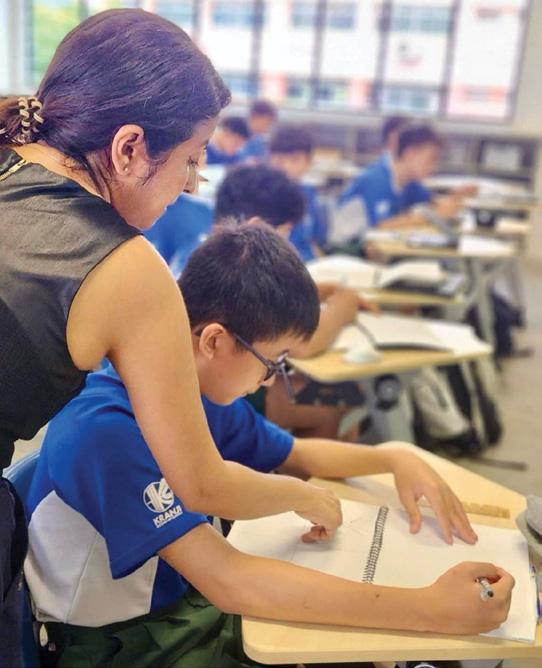
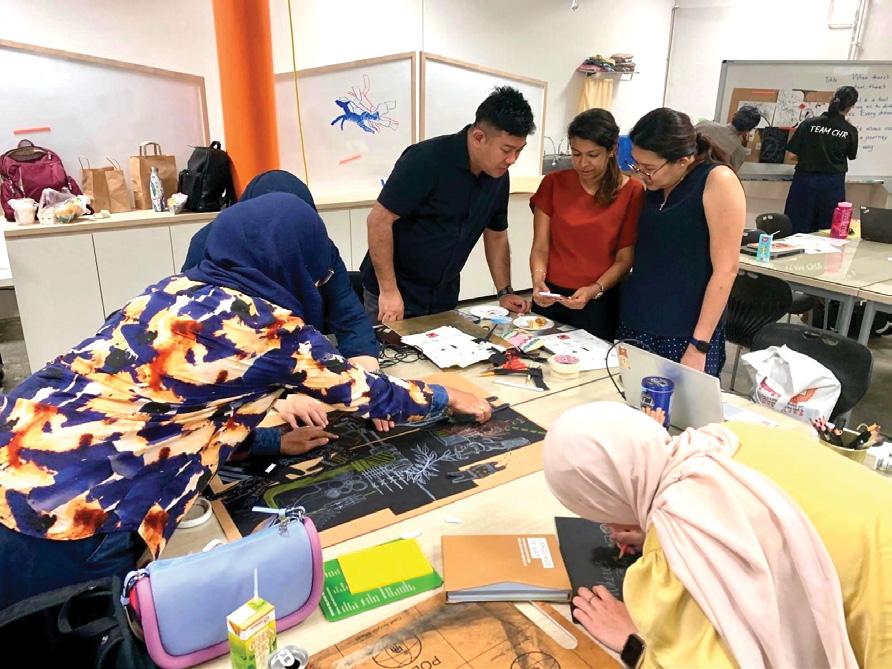
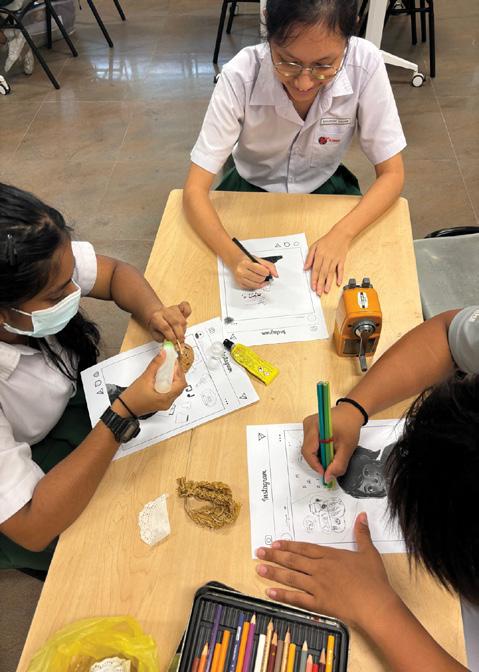
Through this renewed lens, I designed lessons that encouraged playful experimentation and collaboration in my Art Classroom. I introduced collaborative “Playlist” exercises incorporating prompts such as drawing with unconventional tools and creating art from found objects. Seeing how much creative energy was released when students were encouraged to take risks was eye-opening! The way my students played, reflected, and responded mirrored the spontaneity and authenticity I had experienced in the NLC. My students became more self-assured, inquisitive, and open to new possibilities.
Today, I continue to instill in my students a sense of wonder, resilience and discovery sparked by my NLC experiences. Being an NLC member has been an important part of my growth and journey as a teacher – a reminder of the creative connection I share with my students, and reaffirmation that all it takes to ignite creativity is a tiny spark.
“...all it takes to ignite creativity is a tiny spark.”

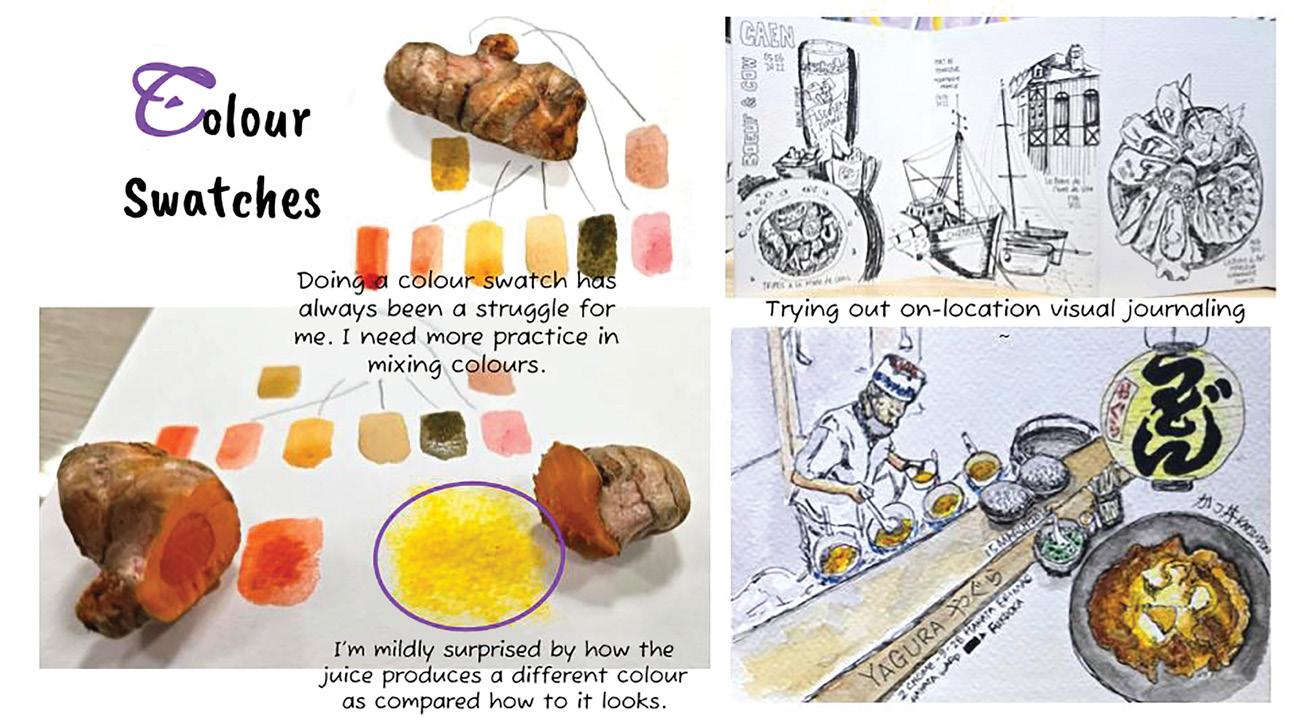
Ms Jessica Lai
After years of setting aside her own drawing practice, Ms Jessica Lai from Anglo-Chinese School (Primary) rediscovers the joy of sketching, and is reminded that creativity begins by slowing down and experimenting freely.
Ms Vernice Soh Bee Sembawang Primary
Ms Vernice Soh Bee to refine her craft and
I believe strongly in teaching practice and inspirations, and growth my evolving creative courses. In my travels, details and colours. Annotating during this consistent practice and
As art educators, we often spend time teaching others to create while neglecting our own practice. I had stopped sketching for years until I attended Paul Wang’s “Drawing as Thinking” workshop. Exploring line quality, painting big shapes, and drawing on top of wet paint were some ideas I learnt that helped me to approach sketching without any fear. More importantly, setting aside time to sketch has become a way for me to try out ideas, which then sparks even more ideas. Sketching also forces me to slow down, to wonder, to discover. In turn, I find more inspiration and clarity when crafting learning experiences for my students.
About my sketchbook page:
All of these sketches were done after the workshop during brief windows of time – at cafes while waiting five to 10 minutes for the food to arrive. The first was made on 5th April, and you can see how I struggled with the human form. I usually began by looking for a “leading line” that journeys across the page and ties all the elements together. I have also been trying to apply the ideas I learnt at the workshop, such as painting in big shapes first and using high contrast to create focal points. These three sketches were painted on site and then refined at home, where I increased contrast and added more details.
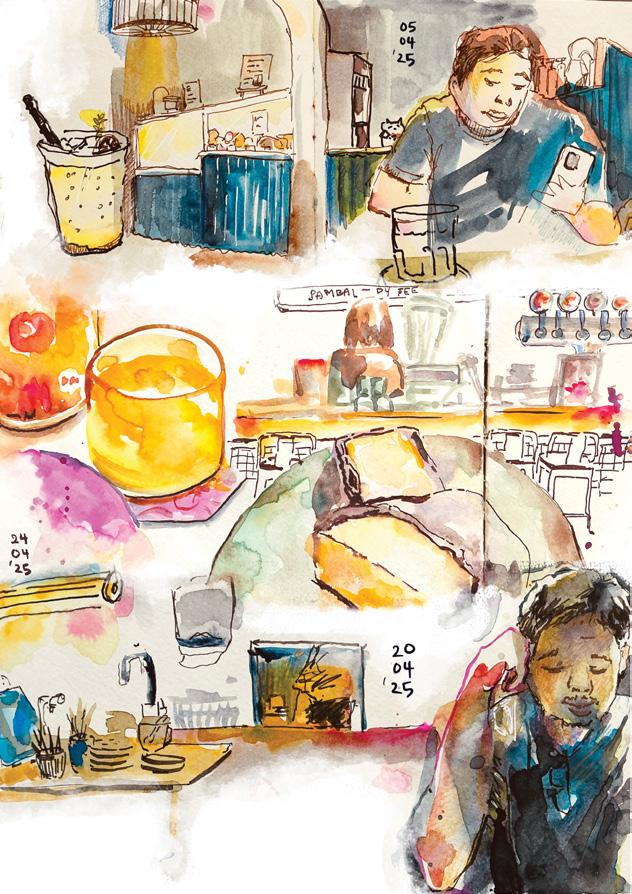
Bee Peng
Primary School
Peng from Sembawang Primary School shares how she uses her sketchbook and bring fresh insights into the classroom.
embracing continuous learning and artistic growth as part of my creative journey – and as a way to propel my and transform experiences into meaningful teaching moments. What better way to record my observations, growth than with a trusty sketchbook that serves as both a personal sanctuary for artistic discovery and a chronicle of practice? My sketchbook documents my visual travel diaries and insights gained from professional development travels, I like to take some time to observe my surroundings and draw what attracts my attention, before adding the I also enjoy learning new skills in art workshops, such as creating colour swatches through close observation. this exercise helps me remember the process, making it easier to revisit and apply those skills later. Through and detailed documentation of my observations and learning experiences, I continue to refine my artistic practice.
Master Teacher, Mr Chia Wei Hou
STAR
Blending creativity with pedagogy, Master Teacher Mr Chia Wei Hou from STAR embraces his identity as an artist-teacher, designing lessons that are intuitive, imaginative and inspired by the artistic process.
Being an art teacher is a unique and privileged position – we wear two hats: educator and artist. Each role is complex in its own right, yet together they offer a deeply creative, inspiring experience. This dual identity gives rise to the artist-teacher. My lesson planning reflects this. Just as I approach artmaking, I design lessons in a fluid, organic way – connecting unlikely ideas and imagining new possibilities. I stray from rigid, linear frameworks, favouring a more intuitive, imaginative path. My approach is inspired by Paul Klee’s Pedagogical Sketchbook, which reminds us how to think like artists and designers even as we teach.
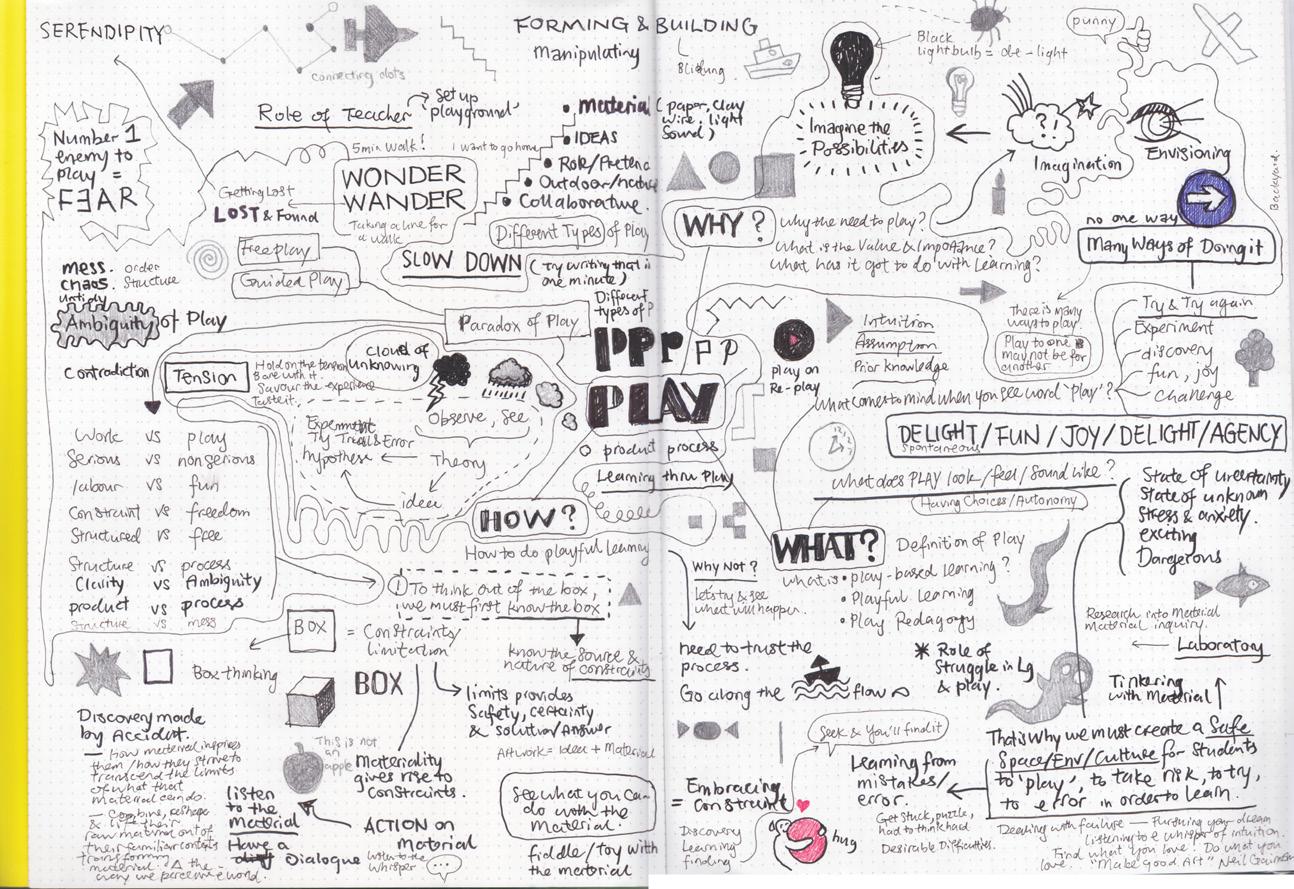
Miss Liew Ziyi | Subject Head of AeAS department
Miss Hailey Tan | Art and Drama Teacher
Miss Thng Shalyn | Art Teacher Xinmin Secondary School
The revised Art syllabus marks a refreshing and meaningful shift. We appreciate how it brings us back to the core of teaching and learning – engaging students through smaller, diverse art and design tasks that spark authentic conversations and thoughtful reflection. While the transition may feel challenging at first, we believe the journey will be worthwhile. What excites us the most is how the syllabus strengthens the connection between art and our environment, encouraging students to view the world around them as a source of inspiration, stories, and new perspectives. We’re excited to engage in more spontaneous drawing exercises that encourage creative processes and explore possibilities through art journalling.
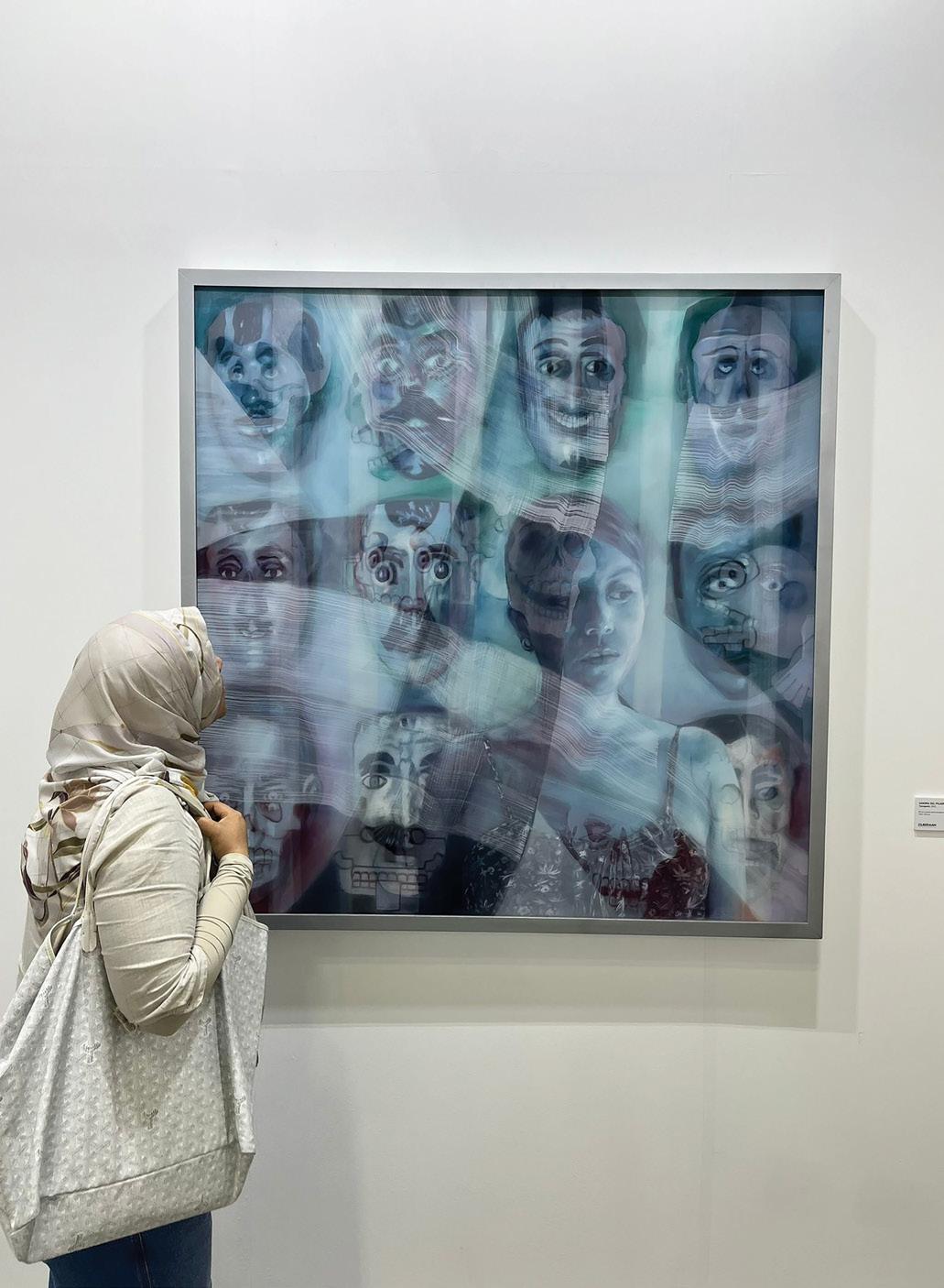
Ilyana
Visiting art exhibitions, whether overseas or here in Singapore, is something that I always look forward to. It keeps me connected to the ever-evolving language of contemporary art and reminds me there is always more to learn. I attended ART SG held at Marina Bay Sands earlier this year. The visit made me feel like a student again – leaning in, asking questions, not always finding answers, but loving the process of figuring things out. It was an important reminder of the value of staying open and curious – not just about art, but about the world around me. That same sense of wonder is what I hope to spark in my students through the learning experiences I design.
Ms Shehana Zulazmi
CHIJ St Theresa’s Convent
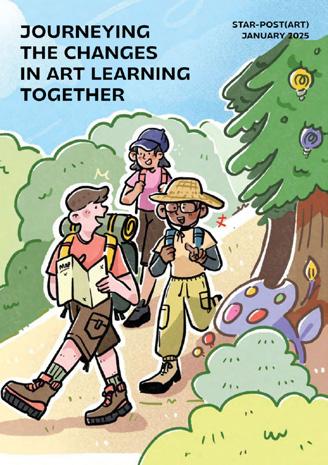
I was inspired and felt reaffirmed after reading “Portfolio Learning in Action” in the January 2025 issue of the STAR Post (Art). Integrating portfolio-based learning early in the Secondary 1 Art curriculum encourages students to document their creative journey, develop habits of reflection, planning, and self-assessment right from the start.
The use of common platforms like Google Slides and Padlet was particularly effective. By recording research, ideation sketches, construction plans, and progress photos in one place, students took ownership of their creative journey. Reflection became part of their practice, not an afterthought. This is similar to what we do at CHIJ St. Theresa’s Convent, where digital platforms are also used to foster such reflective processes. The idea of a “Documentation Station” – a dedicated area equipped for creating quality documentation photos – is something I would like to introduce in my own art room.
Another strong feature was the emphasis on planning through drawing. Students didn’t just make things – they thought like designers. Two-point perspective sketches, measured plans, and labelled construction diagrams revealed critical thinking and problem-solving skills. At the heart of it all was the link to History. Students drew inspiration from the stories of migrant workers in Singapore, encouraging empathy and deeper engagement with the subject matter. Art tells stories about our world, indeed!


Ms Katie Tan Si Hui Angsana Primary School
My journey as a beginning art teacher has been filled with ups and downs. Juggling administrative duties, lesson planning, teaching, and managing diverse student profiles felt overwhelming at first. There was so much to learn, but each challenge has been an eye-opening and fulfilling experience that strengthened my resilience and deepened my passion for teaching. These moments have added value to my development as an effective educator. A meaningful insight I’ve gained is the value of integrating personal creative habits into the classroom. Tapping into my experiences and strengths has helped me design learner-centric lessons. Visiting new art exhibitions keeps my inspiration fresh, while doodling as a form of visual note-taking helps me focus and process ideas better. Sharing these practices with my students has encouraged them to find personal ways to connect with art. As I grow in my role, I find myself growing alongside those I teach, in meaningful and purposeful ways.
“...I find myself growing alongside those I teach, in meaningful and purposeful ways.”

Victoria Loy
Master Teacher (Art) Victoria_LOY@moe.gov.sg
Master Teacher (Art) LIM_Kok_Boon@moe.gov.sg
Rafeeza Khaliq Academy Officer (Art) Rafeeza_Khaliq@moe.gov.sg
Vivian Loh
Master Teacher (Art) Vivian_LOH@moe.gov.sg

Silvia Lim Academy Officer (Art) Silvia_LIM@moe.gov.sg
Ira Wati Bte Sukaimi Master Teacher (Art) Ira_Wati_Sukaimi@moe.gov.sg
Chia Wei Hou Master Teacher (Art) CHIA_Wei_Hou@moe.gov.sg
Chun Wee San Master Teacher (Art) CHUN_Wee_San@moe.gov.sg
Han Zi Rui Senior Assistant Director (Art) HAN_Zi_Rui@moe.gov.sg
Seow Ai Wee Master Teacher (Art) SEOW_Ai_Wee@moe.gov.sg
Contact Us: MOE_STAR@moe.gov.sg http://star.moe.edu.sg/ +65 6664 1496
Nurulhuda Mustafa Academy Officer (Art) nurulhuda_mustafa@moe.gov.sg




